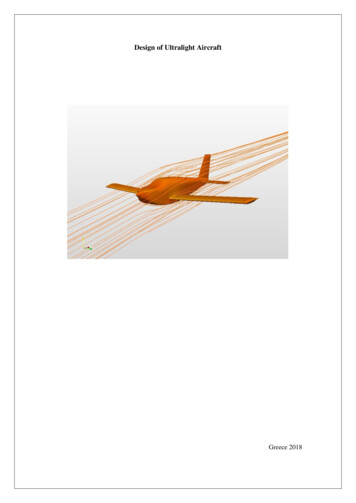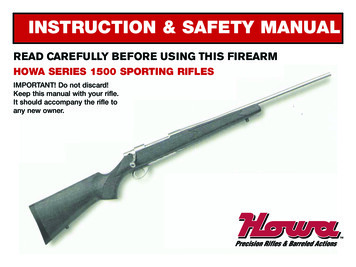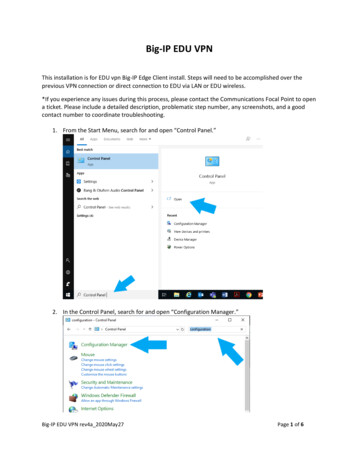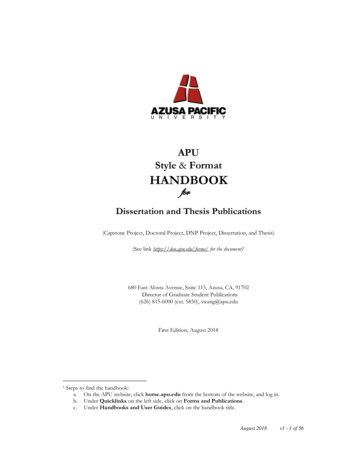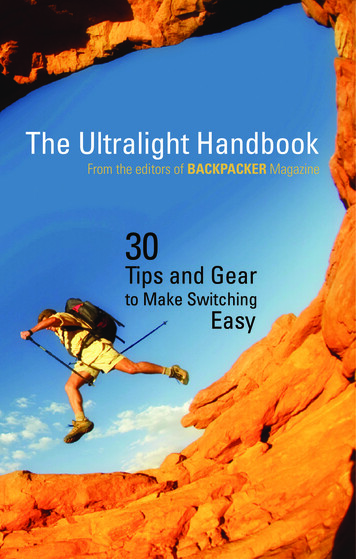
Transcription
The Ultralight HandbookFrom the editors of BACKPACKER Magazine30Tips and Gearto Make SwitchingEasy
THE SKILLSUltralight or BustA 10-step plan for getting your base pack weightunder 15 pounds.- By Michael LanzaGoing light is a bit like marriage: It’s a multifaceted contractthat requires your constant commitment. Cheat just a littlebit, and your hike—and especially your shoulders—willsuffer. But stick to these rules, and you’ll quickly find a newcomfort level with 15-mile days.Question EverythingStep 1The only way to make ultralight work is to ditch your standard gear list andyour gotta-have-my-coffee-press ’tude. A checklist tricks you into bringinggear you don’t need—like a tent in the Sierra—and the attitude distortsthe hard choices you’ll have to make to trim the last five pounds. For yournext trip, start from scratch and select only the gear that’s absolutely critical for the conditions you’ll face. If in doubt, leave it out.Weigh It AllStep 2It’ll open your eyes to the surprisingly heavy items—like a filter or first aidkit — and to the little things that individually weigh next to nothing but together add up to something real. Allow yourself a luxury item (recommendation: a comfortable sleeping pad), but otherwise eliminate or substitutewith a ruthless eye for fat and duplication. Example: Swap your knife for arazor blade, which is just as effective in most medical situations.Rethink ShelterStep 3This is the place to make a major dent: Most serious ULers carry tarpsthat weigh less than a pound without stakes and guylines. If you needa three-season tent for bugs or heavy rain, try the superlight Big AgnesSeedhouse SL2 (2 pounds, 14 ounces; 319). Or split the difference witha tent that pitches with just rainfly, poles, and footprint. On the AT andLong Trail, plan to sleep in the shelters that appear almost every 8 miles,unless it’s a busy weekend.BACKPACKER The Ultralight Handbook
THE SKILLSChange Your BeddingStep 4Old thinking: Choose a sleeping bag for the lowest temps you mightencounter. New thinking: Aim for the middle, and wear more clothes if acold snap hits. Hard-core fastpackers hit the trail predawn—typically thecoldest hour of the night—when they start feeling chilled in their lightweight bags. You can also lose pad weight (and bulk) without sacrificingcomfort: Carry a short model and place your empty pack under your feet.Layer DownStep 5Another tired maxim: Carry extra clothing. Sure, you want to be cozy andsafe, but thick down in July is overkill. Choose layers based on the forecast, and don’t double up (no wind jacket and rain shell). For three-seasontrips, your shell should weigh under a pound; the lightest are a mere 8ounces. Pack a midweight long-sleeve top, one synthetic T, lightweightshorts and pants, a light down jacket (10-12 ounces.), two pairs of socksand underwear, two hats (for sun and warmth), and (maybe) light glovesand rain pants.Improve Your DietStep 6This is a hard sell for caffeine junkies, but do you really need a hot drink(or meal) in summer? Even the lightest stoves add ounces, especiallywhen you tally fuel and cooking-gear ballast. Leave it home in favor ofpeanut butter, tortillas, cheese, jerky, pepperoni, dried fruits, nuts, sesamesticks, and peanut M&Ms—all of which are satisfying, nutritious, andpacked with calories. And that extra food you always carry? Skip it. Evenremote trails are usually within a day’s hike of a road, and hunger wouldtake weeks to kill you. Besides, when’s the last time you ran out of chowon a trip?Ditch the MapStep 7Hiking without a topo (and guidebook) isn’t sane everywhere, but manytrails are so well marked that no seasoned hiker could get lost. If youmust carry a map, trim the superfluous parts. If you’re thru-hiking, carryonly the section you need between resupplies—and find the lightest version available. The set of 13 maps from Tom Harrison covers the entireJMT and weighs just three ounces, about the same weight as the TrailsBACKPACKER The Ultralight Handbook
THE SKILLSIllustrated map of Yosemite, which covers just a fraction.Downsize Your PackStep 8Your streamlined load should fit in a pack with about 3,000 cubic inches ofcapacity. And you no longer need an elaborate (read: heavy) suspension.Ultralight packs typically consist of a simple, lightly padded harness and aminimalist frame. They weigh six ounces to two pounds and comfortablycarry up to 25 pounds.Take Less MedicineStep 9Your kit should weigh no more than eight ounces: All you really need isantibiotic ointment, duct tape, a few gauze pads and bandages, a bit ofblister treatment, and your WFA training (you got that, right?). In the field,sub what’s available: sticks for SAM splints, a cold stream for an ice pack,a T-shirt for a dressing.Empty Your BottlesStep 10Tradition holds that you need to carry two to three liters of water at alltimes. But at 2 pounds, 2 ounces per liter, water is one of the heaviestthings you’re schlepping. Instead, drink opportunistically. Along manymountain trails, you rarely need to carry more than a liter—if any. Elsewhere, check distances between sources and tank up just enough thatyou’re nearly empty as you reach each one. Then guzzle away as yourefill. Finally, forego a filter in favor of a lightweight water treatment likeAqua Mira.BACKPACKER The Ultralight Handbook
THE MENUBe an Ultralight GourmetNo, it’s not an oxymoron. You, too, can say buhbye to endless energy bars and instant rice glop—and eat like royalty for less than two pounds aday.- By Kristen HostetterGoing light is a bit like marriage: It’sa multifaceted contract that requiresyour constant commitment. Cheatjust a little bit, and your hike—andespecially your shoulders—will suffer.But stick to these rules, and you’llquickly find a new comfort level with15-mile days.So how can you follow the rules andstill make a gourmet meal that doesn’tweigh you down like too much foiegras? We’ve found the Holy Grail,and it comes in the form of a freezerbag—or, rather, on freezerbagcooking.com. The Web site, and itscompanion cookbook,Freezer Bag Cooking:Trail Food Made Simple,is the brainchild ofSarah Kirkconnell, anavid backpacker, cook,and ultralighter. Herpremise is simple:Pack singleBACKPACKERportions of dehydrated meals intoquart-size freezer bags. In camp, addboiling water, stir (with a spoon, toavoid fork punctures), insulate yourbaggie, let sit, then chow down.Since you “cook” and eat right out ofthe bag, there’s no dish duty (just addthe baggies to your garbage) and noneed to pack anything other than oneboiling vessel. There’s no simmering.No watched pots. Kirkconnell’stechnique, combined with the rightgear and your favorite trail-adaptedrecipes, could slash your food weightby about half (depending on howyou originally pack). Allyou need to know ishow to dehydrateyour grub,what mealsto put onyour menu,and whichounces tocount. Onceyou bag it,you’ll never turnback. The Ultralight Handbook
THE GEARThis five-piece kitchen weighs only 13.3 ouncesand cranks out gourmet eats.- By Kristen HostetterAntigravity Gear Caldera KitchenThis alcohol stove system has it all: utter simplicity. Wispy weight. An ingeniouspacking system. It’s a tiny burner, made from a V-8 can nestled inside a Pepsican, that burns denatured alcohol. But what makes the Caldera unique is theway the system is integrated: The aluminum windscreen forms a rigid cone,which holds the 3-cup nonstick aluminum pot perfectly suspended over theburner—and efficiently captures the alcohol’s BTUs. (We used less than 16ounces of fuel on a five-day trip for two.) Boil times averaged about 8 minutes,and the whole system packs away into an insulated 1-quart, lidded plasticcontainer, which doubles as a bowl, coffee cup, and cooking cozy. As tested, itweighs a scant 10 ounces. 73, (910) 794-3308, antigravitygear.com.32-ounce Gatorade BottleSkip the Nalgene bottle and reach into your recycle bin for oneof these. One empty bottle weighs only 0.11 ounces—that’s 2ounces less than a regular Lexan Nalgene. Gatorade bottles areimpressively strong: You’ll get at least three months of use outof them, and then you can recycle them.FBC (Freezer Bag Cooking) Fabric CoziesThese pouches, made from Mylar and polyester, weigh just 1.5ounces, are sized perfectly for a quart-sized ziplock bag, and act like aportable oven. Just add hot water to the bag and snuggle it into the cozy, whichcooks a dehydrated meal in under 10 minutes. 14, freezerbagcooking.com.Jetboil Jetset SpoonThere are lots of spoons and sporks out there, but this 0.4-ouncer is in a leagueof its own. The handle is long enough for eating out of a zip-top bag withoutgetting gunked up, but it collapses into a neat 5 inches. Set of three includes forkand spatula. 20, (888) 611-9905, jetboil.com.Fozzil Thinkflat BowlThis clever item—it packs flat, but morphs into a bowl with four corner snaps—pulled triple duty on a recent trip in Colorado’s Holy Cross Wilderness. First,it provided a handy receptacle for our soft-sided bag cozies. Second, it madea great cutting board for slicing cheddar at lunchtime. And third, it became afunctional butt pad on wet, cold logs. And all at 1.3 ounces. Just rinse before youeat (or sit). 5, Fozzils.com.BACKPACKER The Ultralight Handbook
THE RECIPESThree tasty dinners – the freezer bag away.Beef Stroganoff- By Kristen HostetterServes one: 5.5 oz.Combine in a quart-size ziplock:1 package beef-flavored Ramen (including seasoning packet)¼ cup dehydrated ground beef¼ cup mixed dehydrated veggies1 tsp. paprikaDash of cayenne pepperIndividual packet of cream cheese (equal to about a tablespoon; grab one at yourfavorite bagel shop)Salt and pepper to tasteIn camp Add about 1 ½ cups boiling water to baggie. Squish it around and letit rest in a cozy for 10 minutes or so, until the burger is tender. Stir in creamcheese.American Chop SueyServes one: 4.5 oz.Make a double batch of this at home. Have it for dinnerwith your family, then dehydrate half for your next fewbackpacking trips.1 Tbs. olive oil1 lb. lean ground beef1 28-oz. can crushed tomatoes1 6-oz. can tomato paste1 chopped onion1 chopped bell pepper (any color)2 Tbs. dried oregano2 Tbs. dried basil1 tsp. crushed red pepper¾ lb. elbow noodlesSalt and pepper to tasteOptional: cubed cheese, any kindAt home Heat oil and gently sauté the onion and pepper until onion istranslucent. Add the meat and brown thoroughly, breaking it up as you go witha wooden spoon. Drain off accumulated fat. Add the spices, then tomatoes, andBACKPACKER The Ultralight Handbook
THE RECIPESsimmer for about 15 minutes. Meanwhile,the pasta till al dente and drain. Letthe sauce cool, then spread it onthe dehydrator trays. (If you don’thave tray liners, cut wax paper to fitthe shape of your trays.) Spread thecooled macaroni on separate trays,making sure it doesn’t stick together(rinsing with cool water first helps).Dehydrate both components until they’rebrittle (about 6 hours or overnight). Whendone, combine 1 cup macaroni and 1 cupsauce in a 1-quart ziplock.cookIn camp Add about 2 cups boiling water to the bag,squish it around, and let it rest in a cozy for about 10minutes, or until everything is tender. Top with cubed cheese.Spicy Curry Noodle BowlServes one: 6 oz.1 serving of Asian cellophane noodles (They typically comein large bricks. Break off a 3- by 6-inch chunk.)¼ cup dehydrated meat of your choice (burger or chicken)¼ cup dehydrated mixed veggies1 Tbs. curry1 Tbs. cumin1 Tbs. coriander1 Tbs. garam masala½ tsp. ground ginger2 Tbs. coconut cream powder2 Tbs. dry milkDash of cayenneSalt and pepper to tasteHandful of cashewsIn camp Add about 1 ½ cups boiling water to baggie. Squish it around and let itrest in a cozy for 10 minutes, or until everything is tender. Top with cashews.BACKPACKER The Ultralight Handbook
THE RECIPESREADER RECIPE CONTESTAnd the Winner Is . . .Our online call for entries yielded some yummy results. Thetrue champion? Karla Coreil of Port Allen, Louisiana, whocame up with a lunch idea that has all the right ingredients:It’s easy, fast, light—and big on flavor and nutrition.Mom’s Carlsbad Spread16 oz. canned diced tomatoes, with juice2 cups garbanzo beans, drained and rinsed (1 can)½ cup lemon juice (about 2 to 3 large lemons)5 garlic cloves4 Tbs. chopped fresh basil (or use 1 Tbs. dried)2 Tbs. extra virgin olive oil2 roasted sweet peppersAt home Combine all ingredients in a food processor and puree until smooth.Spread the mixture on dehydrator trays and dry for about 8 hours or untilcrumbly. Divide mixture into four ziplocks and break down the piecesas much as you can by squeezing the bag (this will speed along therehydrating process).In camp Add equal parts water (cold is fine) to each bag, stir, and letsit for 5 to 10 minutes. Serve on pita, tortillas, or bagels. Makes 4servings.BACKPACKER The Ultralight Handbook
MORE SKILLSCut Winter WeightFour ways to pack light and stay warm.- By By Michael LanzaEven with global warming, winters still get cold in much of the country, and fearof freezing often motivates hikers to overload their packs with clothing and gear.But just because there are 10 inches of fresh snow on the ground doesn’t meanyou need to equip for the Arctic. Try these weight-saving tips to keep your packthree-season light.Downsize your shellLeave the bulky, insulated waterproof/breathable jacket at home. It’s fine forwindy chairlifts, but too warm for winter hiking and snowshoeing. With lightermaterials and spare designs, today’s hooded shells weighing about 16 to 24ounces are ideal for winters in the lower 48—and all you’ll need to wear over abase layer when moving on snowy, windy days.Adjust your layersBuild insulation with multiple lightweight layers that work together instead ofheavier layers worn alone. Slip a midweight fleece (vest or jacket) over a longsleeve base layer when on the go. Retain heat during rest breaks by addinga hoodless puffy jacket weighing 1.5 pounds or less. In camp, wear insulatedbooties.Fine-tune your sleepBring only as much bag as you need. Warm sleepersshould select a bag rated for the nighttime lows, whilehuman popsicles should aim for a rating 10 F to15 F lower. Use two pads for ground insulation: afull-length foam pad underneath a shorter inflatablemattress.Save your stovePack liquid-fuel stoves (e.g., white gas) for wintertrips. Unlike canister cookers, they don’t sputter whentemperatures dip below freezing. Bring 10 fluid ounces ofwhite gas per person per day if you need to melt snow,and half that amount if water is available. Stick withlightweight, one-pot meals that require only hotwater.BACKPACKER The Ultralight Handbook
MORE SKILLSThe MethodSucking all the moisture out of your food is thekey to eating well and eating light.- By Kristin HostetterBecause most food weight is water weight, it’s impossible to really go ultralightgourmet without investing in a basic food dehydrator, which won’t set you backmore than 50 bucks. With these tips, you can transform your favorite at-homemeals into featherweight, just-add-water trail delicacies. Precook and dry your pasta.You’ll save substantial cooking time in camp, not to mention fueland weight. Simply cook your pasta al dente at home, then spread iton dehydrator trays and let it go for a couple of hours until brittle. Incamp, add boiling water, then cover and let sit for a few minutes. Feed your inner carnivore.Start with lean ground beef, turkey, or chicken. Brown it along withany seasoning you like. Suggestions: Asian (curry, cumin, coriander)or Italian (oregano, basil, thyme). When the mixture is browned,rinse it under hot water to remove residual fat, then dehydrate untilthe nuggets are very hard (about five hours). Break the meat up intofine particles for easier rehydrating. Get saucy.Maybe it’s your famous red pepper and Vidalia onion sauce. OrGrandma’s Bolognese. Whatever the condiment, you can probablydehydrate it. All you need are plastic tray liners and a dehydrator.Spread the sauce in a very thin layer and let it rip for 8–10 hours,until it becomes a featherweight leather. Add hot water, and eat.BACKPACKER The Ultralight Handbook
MORE SKILLSNumber CrunchingWant to be a die-hard ultralighter? You’d betterget OCD about counting ounces—especially whenit comes to food. Know your appetite.Keep notes on exactly how much, say, pasta you pack per meal,and whether or not it leaves you satisfied, hungry, or toting outleftovers. A common mistake is to cook too much food—andnobody wants to deal with a sodden garbage bag full of uneatenrice and beans. Read the labels.Backpackers can’t afford to haul around empty calories that don’tpack a nutritional punch. Look for high protein, carb, fat, andvitamin contents; steer clear of overwhelming sodium and lengthylists of mysterious chemicals and additives. Invest in a scale.How can you possibly lighten your load without being able tocompare the weights of individual items? Don’t trust manufacturerweights; they are often overly optimistic.BACKPACKER The Ultralight Handbook
RECIPES More SKILLS THE RECIPES Three tasty dinners - the freezer bag away. - By Kristen Hostetter Beef Stroganoff Serves one: 5.5 oz. Combine in a quart-size ziplock: 1 package beef-flavored Ramen (including seasoning packet) ¼ cup dehydrated ground beef ¼ cup mixed dehydrated veggies 1 tsp. paprika Dash of cayenne pepper


